译林版小学英语四年级下册教学设计Unit6
- 格式:doc
- 大小:136.50 KB
- 文档页数:14
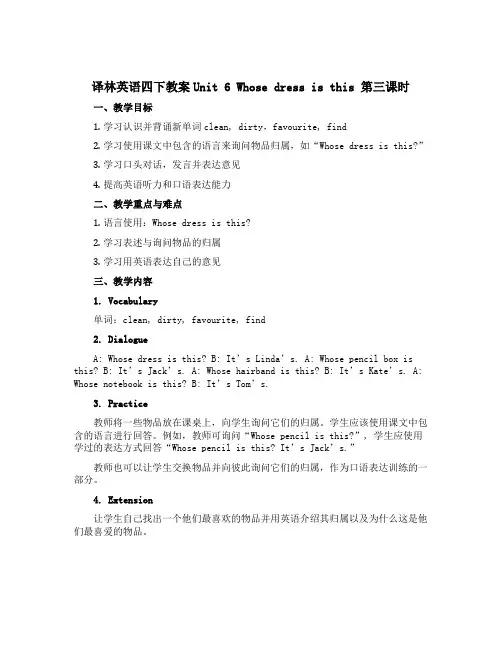
译林英语四下教案Unit 6 Whose dress is this 第三课时一、教学目标1.学习认识并背诵新单词clean, dirty,favourite, find2.学习使用课文中包含的语言来询问物品归属,如“Whose dress is this?”3.学习口头对话,发言并表达意见4.提高英语听力和口语表达能力二、教学重点与难点1.语言使用:Whose dress is this?2.学习表述与询问物品的归属3.学习用英语表达自己的意见三、教学内容1. Vocabulary单词:clean, dirty, favourite, find2. DialogueA: Whose dress is this? B: It’s Linda’s. A: Whose pencil box is this? B: It’s Jack’s. A: Whose hairband is this? B: It’s Kate’s. A: Whose notebook is this? B: It’s Tom’s.3. Practice教师将一些物品放在课桌上,向学生询问它们的归属。
学生应该使用课文中包含的语言进行回答。
例如,教师可询问“Whose pencil is this?”, 学生应使用学过的表达方式回答“Whose pencil is this? It’s Jack’s.”教师也可以让学生交换物品并向彼此询问它们的归属,作为口语表达训练的一部分。
4. Extension让学生自己找出一个他们最喜欢的物品并用英语介绍其归属以及为什么这是他们最喜爱的物品。
四、教学总结本节课,我们学习了课文中的一些基本语言,如“Whose dress is this?”, 学生能够应用这些语言询问和回答物品的归属。
我们还进行了口语表达训练,并提高了学生的听力和口语表达能力。
五、作业要求学生完成Unit 6 中第三课时的相关练习,以答案形式提交作业。

Unit6 My e-friend教学目标:1.能理解课文,并会朗读课文。
掌握课文中出现的新单词、词组和句子:e-friend,email,live,send,study,China,UK,…years old,wait a minute。
2.能运用所学句型和词汇来谈论和介绍网友或朋友。
3.通过观察文本插图,培养学生预测文本信息和提问题的能力。
4.学会在听较长的语段时,能抓住关键词,并进行速记的方法。
5.认识到交朋友是一件好事,但要学会保护自己。
学情分析:本节课的教学对象是五年级的学生。
在学习本课之前,学生已经掌握了一定量有关的词汇和句型,并能运用这些词汇进行日常交际对话。
而且认识新朋友和网友是学生感兴趣的话题,要充分利用这一感兴趣的教学内容,鼓励他们用英语去谈论和介绍网友/朋友。
教学重难点:1.对文本的正确理解和准确朗读。
2.如何谈论和介绍网友或朋友。
教学过程:A.Leading in1.Teacher’s name cardT: Look at the picture.Who’s she?Ss:She’s Miss Shi.T:Yes,it’s me.My English name is Wendy.And this year Iam 34 years old.How old are you?Do you know myfavourite subject?You can ask like this:Do you like …?Ss:…..T:Do you know my hobbies? You can use this sentenseto ask me:What do you like doing?I like reading andtravelling.2.Leading in the topic“My e-friend”.T:This is a globe.Here is our country,China.(板书领读)Lookat the map,where is our hometown,Jiang Su?Ss:….T:Yes,it’s here.And we all live in Jiang Su.(板书领读)Andwe speak Chinese.China is just one country in theworld .There are many other countries.Today we’ll learna new country.Do you know the country?UK(板书领读)Ss:Look at some pictures.(Mr Bean,Big Ben,University ofOxford,some children )T:Which language do they speak,Chinese or English?Ss:English.T:Yes,they can speak Enlish well,and we can speak Chinesewell.Now they want some friends in China.Do youwant to be their friends?But the UK is far awayfrom China,how can we make friends with them?Ss:….T:We can chat on QQ or micromessenger,and we can sendemails,too.When we know a new friend on theInternet,we call this friend is e-friend(板书领读)。
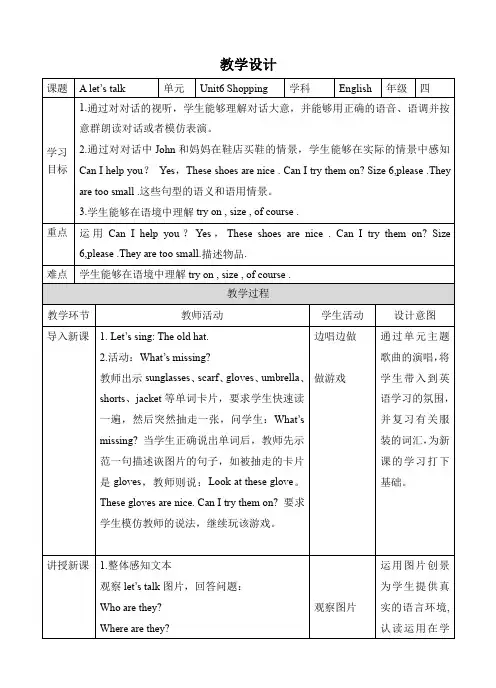
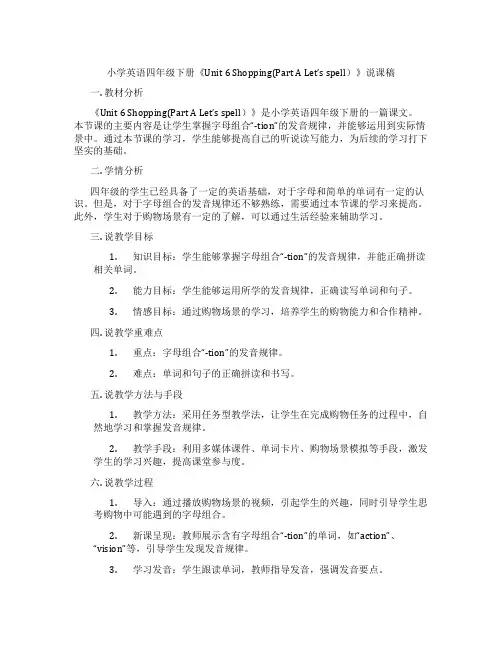
小学英语四年级下册《Unit 6 Shopping(Part A Let’s spell)》说课稿一. 教材分析《Unit 6 Shopping(Part A Let’s spell)》是小学英语四年级下册的一篇课文。
本节课的主要内容是让学生掌握字母组合“-tion”的发音规律,并能够运用到实际情景中。
通过本节课的学习,学生能够提高自己的听说读写能力,为后续的学习打下坚实的基础。
二. 学情分析四年级的学生已经具备了一定的英语基础,对于字母和简单的单词有一定的认识。
但是,对于字母组合的发音规律还不够熟练,需要通过本节课的学习来提高。
此外,学生对于购物场景有一定的了解,可以通过生活经验来辅助学习。
三. 说教学目标1.知识目标:学生能够掌握字母组合“-tion”的发音规律,并能正确拼读相关单词。
2.能力目标:学生能够运用所学的发音规律,正确读写单词和句子。
3.情感目标:通过购物场景的学习,培养学生的购物能力和合作精神。
四. 说教学重难点1.重点:字母组合“-tion”的发音规律。
2.难点:单词和句子的正确拼读和书写。
五. 说教学方法与手段1.教学方法:采用任务型教学法,让学生在完成购物任务的过程中,自然地学习和掌握发音规律。
2.教学手段:利用多媒体课件、单词卡片、购物场景模拟等手段,激发学生的学习兴趣,提高课堂参与度。
六. 说教学过程1.导入:通过播放购物场景的视频,引起学生的兴趣,同时引导学生思考购物中可能遇到的字母组合。
2.新课呈现:教师展示含有字母组合“-tion”的单词,如“action”、“vision”等,引导学生发现发音规律。
3.学习发音:学生跟读单词,教师指导发音,强调发音要点。
4.练习巩固:学生分组进行单词拼读比赛,提高发音准确性。
5.应用拓展:学生模拟购物场景,运用所学发音规律进行交流。
6.课堂小结:教师总结本节课所学内容,强调发音规律的重要性。
7.作业布置:学生回家后,和家长一起找出生活中含有字母组合“-tion”的单词,进行练习。
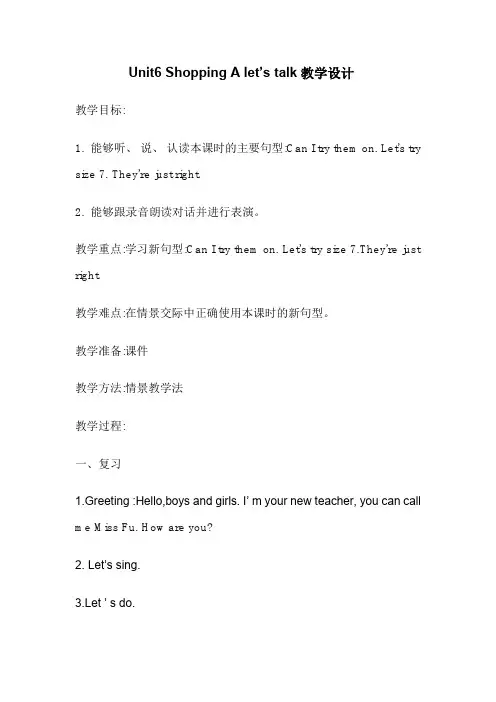
Unit6 Shopping A let’s talk教学设计教学目标:1. 能够听、说、认读本课时的主要句型:Can I try them on. Let's try size 7. They're just right.2. 能够跟录音朗读对话并进行表演。
教学重点:学习新句型:Can I try them on. Let's try size 7.They're just right.教学难点:在情景交际中正确使用本课时的新句型。
教学准备:课件教学方法:情景教学法教学过程:一、复习1.Greeting :Hello,boys and girls. I’ m your new teacher, you can call me Miss Fu. How are you?2. Let’s sing.3.Let ’ s do.4.Guess:衣柜里面有什么?5. 小组评价Today, we have 2 groups .let’s have a look, which group is the best. so come on!二、新知学习1. 学习Can I help you? Yes, these ____ are nice.和The____ is nice.2. 学习Can I try them on? Of course。
3. 学习They’re too small/ too big/ just right.三、学习文本1.初听Listen and answer.(1)T:Today, John 和他妈妈也来到了商场, What do they want to buy?他们想买什么呢? Listen and answer.(2)播放Le t’s talk 视频。
(3)生回答问题。
2.细听并分析Listen and answer.3.跟读:Follow me..小组读。
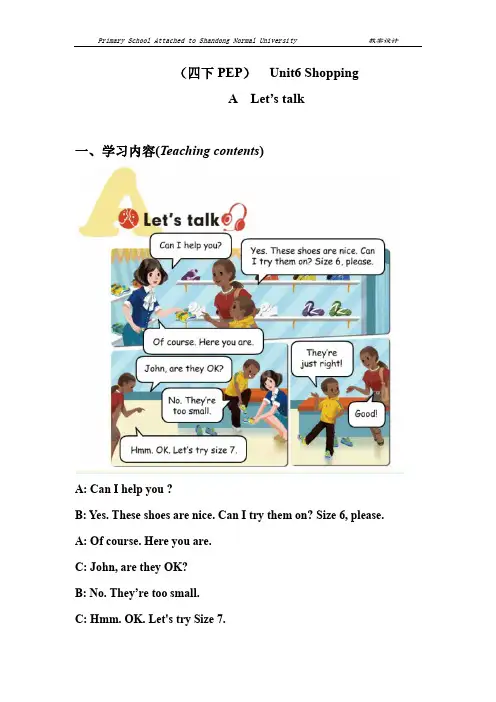
(四下PEP)Unit6 ShoppingA Let’s talk一、学习内容(Teaching contents)A: Can I help you?B: Yes. These shoes are nice. Can I try them on? Size 6, please. A: Of course.Here you are.C: John, are they OK?B: No. They’re too small.C: Hmm. OK. Let's try Size7.B: They are just right!C: Good!二、教学目标(Teaching aims)(一)知识技能目标:1.学生能理解对话大意;能用正确语音语调朗读对话;2.能在语境中理解try on, size, too,just right,of course的意思,并能正确发音;3.能在情境中运用句型Can I help you?These…are ... Can I try…on? Size …,please. They’re too…描述某物品,区分单复数。
(二)学习能力目标:通过同桌练习、小组合作对话、实物情景表演等方式,巩固练习本课的购物用语,进行购物。
(三)情感态度与价值观目标:1.培养学生的合理消费,循环利用资源的积极意识。
2.了解东西方文化中关于鞋码的差异,鼓励学生查找资料自主学习。
三、重点难点(Difficult and important points)(一)教学重点(Important points)1. try on,size,just的含义及发音;2. 句型Can I help you?These…are ... Can I try…on? Size … They’re too…(二)教学难点(Difficult points)size,just的发音;单、复数句型的区分及正确运用。

2022 年版《小学英语课程标准》倡导学思结合、用创为本的英语学习活动观,指出学生要“在体验中学习、在实践中运用、在迁移中创新”“围绕真实语境和真实问题,激活已知,参与到指向主题意义探究的学习理解、应用实践和迁移创新等一系列相互关联、循环递进的语言学习和运用活动中”。
学生的阅读兴趣、阅读习惯、阅读能力对核心素养的提升有着重要的影响。
因此,在本单元教学过程中要充分体现教材的育人价值,激发学生对阅读的热爱之情,培养学生自主阅读的习惯,通过引导学生基于对各语篇内容的学习和主题意义的探究,逐步建构和生成对于阅读的深层认知和正确态度,促进其核心素养综合表现的达成。
单元主题: Holidays 该主题属于人与社会范畴;所属的主题群是生活与学习;涉及“乐学善思,勤于反思,学会学习”。
本单元围绕着“Holidays ” 这一主题展开,涉及五个语篇,包括一个歌曲,四段录音,一个故事,三个听力和一个对话练习。
语篇一是一个听力,能听懂孩子们的假期短文,并找出与短文对应的图片语篇二是一段听力录音,能基本掌握现在分词的变化规则并完成相关习题语篇三是一个故事,能听懂故事,并进行角色扮演。
语篇四是一个歌曲,引导学生根据会话需求,整合、运用已知的句型创编会话,提升语言能力本单元以“Holidays”为主题,紧紧围绕着“假期”开展学习和探讨活动,教材中的四个语篇形式各不相同,但内容相互关联,紧扣单元主题,构成了二个主题意义“学会有关假期的单词及句型”、“学会在实际场景中学会运用句子”。
让学生相互交流个人信息。
所以本单元主要是利用活动来进行,用活动来整合整个教学。
在本单元中有TPR 活动,有对话,有歌曲,主要的内容是让学生了解假期的相关单词、句型来表达运用。
This is…from…. I’m on holiday Arrayin …. I’m ….能听懂孩子们的假期短文,并找出与短文对应的图片以听力的形式进行。
形式引导学生在心理,知识方面做好新课学习的准备。

Unit 6 素养形成卷听力部分(30分)一、听录音,选出你所听到的单词。
(5分)() 1.A.cold B.coat C.boat() 2.A.too B.so C.two() 3.A.right B.light C.wrong () 4.A.these B.this C.it() nd B.hand C.hands 二、听录音,根据所听内容连线。
(5分)三、听录音,选出正确的答句。
(10分)() 1.A.It’s my father’s. B.They are my father’s. C.He’s my father.() 2.A.Try these. B.It’s Su Hai’s. C.Yes, try this.() 3.A.Yes, it is. B.No, I can’t. C.Yes, I do.() 4.A.It’s a beautiful coat.B.That’s my coat. C.It’s on the bed.() 5.A.My leg hurts. B.It’s a sunny day. C.Let’s play.四、听录音,补全句子或对话。
(10分)1.Look at my .It’s short.2.—Yang Ling’s is so .—this, please.3.My and are so beautiful.4.—gloves these?—They’re my .笔试部分(70分)五、英汉互译。
(10分)1.我的聚会2.三件男式衬衫3.我的手4.两条连衣裙5.看我的牛仔裤6.try this coat7.your trousers 8.my mother’s gloves9.so beautiful 10.too big六、单项选择。
(10分)() 1.—Look at gloves.—so big.A.me; They’reB.my; They’reC.I; It’s() 2.—go to the party.—OK.A.Let’sB.LetC.I like() 3.Whose are these?A.trousersB.dressC.book() 4.—Is this a ball?—A.Yes, I can.B.OK.C.No, it isn’t.() 5.—What’s this?—A.They are gloves.B.It’s a coat.C.That’s a coat.() 6.Here your shirt.A.isB.thisC.are() 7.My mother’s trousers are too for me.A.youB.tallC.long() 8.The dresses too short.A.areB.isC.am() 9.—Whose shorts are these?—my cousin’s.A.It’sB.They’reC.That is() 10.Look at toy monkeys.They so lovely.A.this; areB.these; isC.these; are七、用所给单词的正确形式填空。
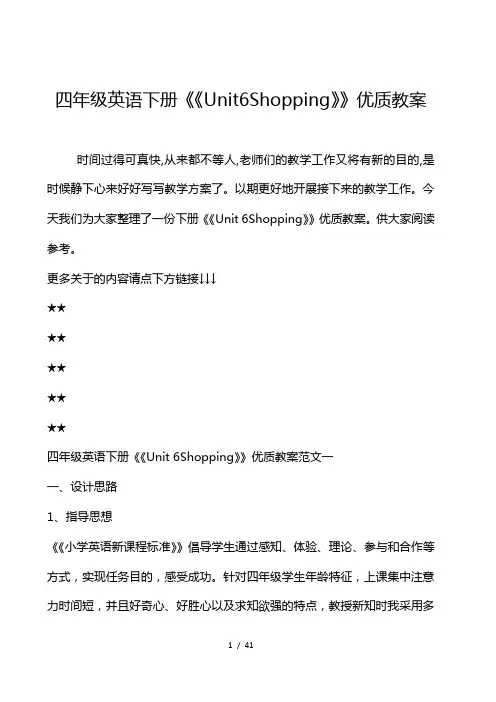
四年级英语下册《《Unit6Shopping》》优质教案时间过得可真快,从来都不等人,老师们的教学工作又将有新的目的,是时候静下心来好好写写教学方案了。
以期更好地开展接下来的教学工作。
今天我们为大家整理了一份下册《《Unit 6Shopping》》优质教案。
供大家阅读参考。
更多关于的内容请点下方链接↓↓↓★★★★★★★★★★四年级英语下册《《Unit 6Shopping》》优质教案范文一一、设计思路1、指导思想《《小学英语新课程标准》》倡导学生通过感知、体验、理论、参与和合作等方式,实现任务目的,感受成功。
针对四年级学生年龄特征,上课集中注意力时间短,并且好奇心、好胜心以及求知欲强的特点,教授新知时我采用多种,进步学生的积极性和主动性。
让学生对单词和进展听、说、认、读,到达纯熟认知的目的;并且根据提示,能写出简短的语句。
存在于生活当中的各个方面,所以在英语教学中我们要让学生学会在真实的生活情境中纯熟的运用所学语言。
我们应该让更多的学生在学习的过程中收获知识、体验快乐,真正做到在“以生为本〞的教育理念的指引下,让学生英语的语言才能、思维品质、品格、学习才能得到更好的培养。
2、教学目的知识目的:可以理解read and write局部的内容,能纯熟地听、说、认、读有关服装和生活用品的单词以及用来修饰服饰和生活用品的形容词和颜色词。
能听、说、读、写重点句型:They’re very expensive. They’re too small.可以理解并纯熟运用句型:They are all five yuan. They’re very cheap. We have many colours for you.过程与方法:通过任务型教学法,交际法和视听法等教学活动,抓住关键词,掌握核心句型,并且尝试复述课文和创编新短文,从而进步学生的语言和学习才能。
情感态度与价值观:让学生树立正确的金钱观,教育学生在平时生活中要节约用钱,不要乱花钱,要谅解父母挣钱的辛苦和不易。

小学英语全英说课稿Book4Unit5 B_人教四年级下Unit 6Lesson 6教学设计教案是教师为顺利而有效地开展教学活动,根据课程标准,教学大纲和教科书要求及学生的实际情况,以课时或课题为单位,对教学内容、教学步骤、教学方法等进行的具体设计和安排的一种实用性教学文书。
今天小编给大家带来小学英语全英说课稿Book4Unit5 B_人教四年级下Unit 6 Lesson 6教学设计,希望可以帮助到大家。
The Lecture Notes of 《 PEP Primary English 》Book4 Unit5 B Let’s talkLadies and Gentlemen, It’s my great pleasure to be here sharing my lesson with you.The content of my lesson is《 PEP Primary English 》Book4 Unit5 B Let’s talk, as king the price and inquiring the clothes size.First, let me talk about the teaching material.Part 1 Teaching Material:This lesson is about a shopping topic. By study of this unit, the Ss know how to ask the price in English and how to describe the size and price with simple words and sentences. The sentence patterns of this lesson “ What size?” “How much are they?” and“We’ll take them .”are the key and difficult points of this unit.The study of this lesson will help the Ss with daily communication.Moreover, this lesson completes the transition of the phrase “a pair of… ”to the sentence pattern “A pair of… for …” ,and helps the Ss further consolidate the knowledge of words of clothing appearing in plural form.Therefore, on studying the teaching material and analyzing the regulation of children’s growing of mind,I put forward the teaching objectives according to English syllabus and new lessonstandard.1.Perception objective:a)The Ss can hear, read, and use the main sentence patterns “A pair of … for …” “What size?” “How much are they?” “We' ll take them.”b)The Ss can understand and read the conversation of the lesson.2.Ability objective:a)The Ss can use the sentence pattern of inquiring the price, and further develop their language ability of “shopping”;b)The Ss can use the patterns to express their thoughts in the proper scene.3.Emotion objective:a)By completing the task,the Ss increase their interest and set up self-confidence in language study;b)Teach the Ss what is “love” and “ managing money matters”, put the moral education in the language study.Next,the key points of this lesson:First of all, to study and use the sentence patterns “What size?”“How much are they ?”“A pair of … for … .” “We' ll take them.”To improve the Ss’ abilities in “shopping”;Secondly, teach the Ss how to study independently as well as by cooperation.Difficult points:The Ss can use the words and patterns to describe the clothes in the proper scene, and make simple dialogues of shopping.Well, how to achieve the teaching objectives better, to stress the key points and break through the difficult points? The key is how to make use of the proper teaching methods, I’ll talk about my teaching methods below.Part 2 Teaching Methods:According to the modern perception theories and social intercourse teaching theories, I adopt the TSA method and TBLT method in my teaching, namely T otal Situational Action and Task-based Language T eaching.The former is a “scene —activity” teaching method .It establishes a real scene and the interaction between the teacher and the Ss .It emphasizes a dynamic information exchange between the teacher and Ss.The latter offers the Ss an opportunity to complete the tasks in which Ss use language to achieve a specific outcome. The activity reflects real life and learners focus on meaning, they are free to use any language they want.At the same time, make use of the modern electricity teaching equipments and all kinds of teaching means, it can mobilize the Ss’ enthusiasm and creativity in learning Engl ish.Part 3 Studying Methods:Let Ss study in a relaxed and agreeable atmosphere. Ss understand the new knowledge in certain degree through the mental process of seeing, hearing, saying, observing, imagining , thinking etc. And make preparation for completing the new study task.After feeling and comprehending the language points, let Ss obtain the knowledge actively by probe study and cooperative study. Thereby, develop the Ss’ abilities of studying and working with the learning language independently.Part 4 Teaching Process:In order to realize the teaching process systematically, properly and efficiently, under the principle of “regard Ss as the corpus, the teacher inspires for predominance”, I divide theteaching process into five steps.Step1 Warm-up.Sing a song: The coat in window.So as to the psychological characteristics of children,singing a song can make Ss feel pleased and satisfied, and can arouse exciting motion. In this step , teacher and the Ss sing in unison and perform the song “The coat in window.” Thus,review the sentence pattern “How much is … ?” And arouse the Ss' performance desire, participation desire,and lead the Ss into a thick English studying atmosphere.Step2 Presentation and practice.1.Design: Look for Cinderella.Broadcast a part of “Cinderella” with the flash, presenting a crystal shoe that Cinderella lose, and establishes a scene of ministers look for the proper size everywhere. Through the role playing, guide the Ss to use the sentence pattern “What size do you wear?” “Size… .”to make the question and answer.This design is a novelty of my lesson,it leads the Ss into the fairy tales. They acquire the language unconsciously and can do communication freely.2.Lead to the shopping topic naturally from the unsuited shoes, and de monstrate the sentence pattern “How much are they?”With a good student to be the assistant, I perform to go shopping, and guide the Ss to make the answer: “They are … .”In this course, Ss can understand the main contents of this dialogue and get the key points by scene demonstration.3.Game:Guess the price.From buying a pair of shoes for myself to buying a pair for my mom, introduce the sentence pattern “A pair of … for … .”The CAI presents a big cabinet with various shoes, ask the Ss to guess their price, and then display them.It considers that children can keep their attentions in limited time. The game can avoid the lifelessness and boredom from the pure machine drills .It creates the conditions of a relaxed and natural atmosphere for children’s d rills. Then achieve the aim of consolidating and deepening the sentence pattern.4.Present the text.a)At this time, John and his mom come to the shoe store.It reappears the relevant conversation by broadcasting the VCD, let Ss know the text contents with a combination of audio and video, words and pictures, which cater to the characteristics of primary period to be curious and pursuing interest and freshness.b)After the audio-visual commences, play the tape recorder completely again, let the Ss concentrate on listening, then answer my questions according to the dialogue. e.g.:What size does John wear? How much? Whether buy or not, etc.c)After be familiar with the text, let the Ss try to act out the dialogue.By this step, it achieved the teaching aim of understanding and talking the dialogue of this lesson.Step3 Task time.Task:Mother’s Day.To master the language capability needs certain amount of practice.So,I still adopt the “Task-based”teaching method, which is defined by strong practicality and exact task, so as to make break-through about the difficult points of this lesson.In advance, I shall arrange the classroom to some business locations, such as clothes store, shoes store, fruit store etc. I shalldivide the class into groups and play roles, and then give the Ss a certain quantity of specie currency, so that they may choose and buy the gifts for Mother’s Day.For this step, I shall instruct the Ss to use the words and patterns learnt in the process of completing certain tasks. Meanwhile, they may have mutual improvement in exchanging information during the communicating activities.Most Ss can take their parts in the activities, especially for the Ss who have trouble in English study. In the group activities, they can speak a little English with ease. With no doubt, this will encourage them to speak English.In fact, it incarnates a kind of demand of human being.Suhuomulinsiji says:“In one’s mind, there is always a kind of deeply rooted demand, that is the hope to feel oneself a finder and explorer. In Ss’ spirits, such demand is specially strong.”This step also leads to the emotion objective of this lesson, that is to have moral education in this step.Step4 Consolidation and extension.Summarize the whole lesson,and arrange the homework.1.Do the correlative exercises in the activity book.Check the mastering of knowledge of this lesson.2.Ask Ss to interview their friends asking the price and size of their clothing and make records of the information.This content is an extension of the previous lesson, to meet the needs of increasing communicating demand of some Ss.Step5 Blackboard Design.Show on the CAI.(It’s a ….)Anyway, the teaching of this lesson aims to develop not only the Ss' language technical abilities, but also the diverse intelligence by integrated teaching methods.As teachers, to make our English classrooms shine with vitality, we are laid with heavy burden, and we still have long way to go.全英教案人教版小学英语四年级下Unit 6 Lesson 6教学设计1. Teaching aims Let the students to master : family, parents, uncle, aunt, baby, come, who, basketball player, people, member, only, puppy, gee, look, young brother, sister, father, mother, driver, doctor, farmer, nurse2. Teaching aids A projector ,a tape recorde, some pictures and photos3. Teaching steps 1)Greetings Say “Hello” to everybody, talk something about the weather and the date.Then sing a song named “ An apple a day makes a doctor away”. 2)Revision Do the exercise on page 76. Ask them to do it in groups and make some coments. Do the exercise “Let’s check” listening to the tape. Then check them in pairs. Do the exercise “Let’s find out” to see how many words can they find in the letters. Tell the main idea of the story in English and ask the students to read it by themselves. Ask them to circle the difficult words and expressions. Choose one or 2 students to come to the front to tell others the meaning of the story. Then the teacher correct him/her. Read the exercise “Good to know” and say sth about it. 3)Sing a song Learn a new song named “My fathe r is a doctor”by listening to the tape.4. Homework Let them to remember the new words in this unit and recite the texts in this unit.5. Teaching notes。

《Unit6 Shopping》教学设计教学内容:《义务教育教科书英语(三年级起点)》(人民教育出版社)四年级下册Unit 6 Shopping对话课。
教学目标:语言知识目标1. 学生能够听懂、会说A部分Let’s talk中的句型:Can I help you? These shoes are nice. Can I try them on? Size6,please. They’re too small.2. 能够理解并完成Let’s play 部分的内容。
语言技能目标学生能在图片、实物或情景的帮助下,运用句型: Can I help you? These shoes are nice. Can I try them on? Size6,please. They’re too small.情感态度目标初步了解商店文明用语。
学习策略目标1.利用游戏等活动让学生在交际的过程中习得核心句型;2.以小组合作的学习形式,培养学生合作意识和能力。
文化意识目标了解中外鞋码的区别。
教学重难点:学生能在图片、实物或情景的帮助下,运用句型: Can I help you? These shoes are nice. Can I try them on? Size6, please. They’re too small。
教学准备:学生准备课本及文具。
教师准备多媒体课件、奖励卡片、鞋。
教学过程:Step1 warming-up1.Greetings. 师生对话,相互问候,营造积极活跃的课堂气氛。
2.Let’s sing.Let’s enjoy a song. “This old hat”3.Free talk.What can you see in the song?S: I can see old hat/skirt/jeans…T: so many old clothes, so the girl wants to go shopping. Let’s go shopping with her. The girl bought many clothes,look, this is a …/They are…【设计意图】:通过节奏明快的歌曲热身,活跃了课堂氛围,并能由歌曲复习一些衣物类商品的名称。
小学英语-有答案-译林版(三起)英语四年级下册 Unit 6Whose dress is this 练习卷2一、汉译英:整句1. 汉译英。
(1)谁的牛仔裤________(2)瞧我的连衣裙________(3)这么大________(4)你的裤子________(5)这么好看________(6)太短________二、选择正确图片/词句This is my new ________. How nice! ()A.skirtB.jacketC.dress—What are these? ()—They are________.A.shoesB.trousersC.socks三、单选题Whose trousers ________? ()A.is itB.they areC.are they—Whose dress is this? ()—It is ________.A.my motherB.my mother'sC.my father'sA.amB.isC.are四、连词成句连词成句。
1. try, yellow, please, this, coat (.)________________2. my, these, red, are, dresses, cousin's (.)________________3. 1et's, now, to, party, the, go (,.)________________4. small, whose, are, gloves, they, Tao tao (,?)________________5. shirt, look, her, at, his, sweater, and (.)________________五、选内容补全对话/短文从方框中选择正确的句子完成对话。
A: Look at Su Yang's gloves.B: 1. ________.A: 2. ________.B: They're her father's.A: 3. ________.B: It's my cousin's.A: 4. ________.B: Thank you. 5. ________.A: All right.六、排序题给下列一段对话排列顺序A.Try these, please. These are short.B.Look at my trousers.C.Thank you. Let's go to the party now.D.Oh, they're too long. Whose trousers are they?E.They're my father's.__________________________________________参考答案与试题解析小学英语-有答案-译林版(三起)英语四年级下册 Unit 6Whose dress is this 练习卷2一、汉译英:整句1.【答案】(1)whose jeans(2)look at my dress(3)so big(4)your trousers(5)so beautiful(6)too short【考点】汉译英【解析】此题暂无解析【解答】(1)谁的whose,牛仔裤jeans,故答案为whose jeans.(2)瞧look at,我的my,连衣裙dress,故答案为look at my dress.(3)这么so,大的big,故答室为so big.(4)你的your,裤子trousers,故答案为your trousers.(5)这么so,漂亮的/好看的beautiful,故答案为so beautiful.(6)太too,短的short,故答案为too short.二、选择正确图片/词句【答案】C【考点】动词短语系动词名词【解析】此题暂无解析【解答】句意:这是我的新连衣裙。
Unit 6 Shopping第一课时教学内容:A. Let ’s learn 、A. Complete and say教学目标:知识与技能:1.能听、说、认读单词:sunglasses, scarf, gloves, umbrella.2.能熟练运用句型:Can I help you? The gloves are nice. Can I try them on?Sure. 来对本节课单词进行模拟购物。
3.了解知识点:可数名词的复数形式,如:gloves, sunglasses等等。
4.语篇提升:Can I help you? Thegloves are nice. Can I try them on ? Sure. Howmuch is it? It ’ s 20 yuan. OK, we ’ ll take them.过程与方法:学生能在合作交流中使用新语言进行沟通情感与价值观:通过学习学生比较喜欢的话题,进一步提高学生学习英语的兴趣,在小组合作过程中,培养学生团结协作的精神。
教具准备:教学光盘、单词卡片、PPT。
教学重点:1.学习单词sunglasses, scarf, gloves, umbrel:la。
2.能熟练运用句型:Can I help you? The gloves are nice. Can I try them on?Sure. 进行问答练习,并能在实际生活中灵活运用。
教学难点:1.合成词sunglasse的勺复数的发音规律。
2. 可数名词的复数形式在句子中的正确使用。
教学过程:一、热身(Warm-up)(此环节用时5分钟)说唱做演,激情引趣(一)歌曲、歌谣中情绪热身Let ’ s sing师生齐唱课本第54 页歌曲“ Thisold hat 。
”(二)复习旧知中知识热身学生两人一组上台表演第58页Let' s talk对话。
(三)评价分组中注意力热身四人一组,准备一张画有一个晾衣架的白纸。
四年级下册英语教案-Unit 6 Whose dress is this 课时2 Fun time & Rhyme time 译林版(三起)课程背景•年级:四年级•课题:Unit 6 Whose dress is this•课时:第2课时,Fun time & Rhyme time•出版社:译林版(三起)课程目标•学习颜色单词和简单的歌谣。
•能够听懂、理解歌谣。
•通过唱歌、玩游戏来提高学生的兴趣。
教学准备•教学PPT。
•蓝色、红色、黄色卡片各10张。
•背景音乐CD。
教学过程Part 1: Warm-up1.唱歌:Hello, Song。
2.问询:How are you today?Part 2: Presentation1.教师出示三种不同颜色的衣服,每个颜色10件,让学生分好颜色放在一起,并在黑板上标记每组衣服的颜色。
2.老师出示一件衣服,让学生猜测它是哪组的。
然后,学生拿出对应颜色的卡片,并用卡片表示自己的选择。
3.让学生报告他们的选择,进行核对。
正确的学生给予表扬。
4.重复以上步骤,让学生熟悉游戏流程。
5.引入Rhyme time部分。
Part 3: Rhyme time1.唱歌:What color is your dress?。
教师要求学生在歌曲中尝试听到颜色单词,帮助他们提前准备。
2.教学一些简单的颜色单词:red、green、blue、yellow、purple、pink。
3.老师用不同颜色的卡片打乱顺序,然后给学生听歌谣,要求他们按顺序举起卡片。
第一次老师可以跟着节奏点头或拍手来帮助学生,然后逐渐让学生独立完成。
4.让学生自由搭配颜色卡片,然后进行搭配练习。
Part 4: Fun time1.学生自由选择三种颜色,把卡片投入对应的桶里。
然后,轮流抽取自己的卡片,并猜测桶里有几张对应的卡片。
2.开始游戏,让学生相互猜测卡片数量。
猜中的学生可以获得相应颜色的卡片。
Part 5: Consolidation1.唱歌:What color is your dress?。
Unit 6 Whose dress is this?习题1一、按要求写单词1、上衣_____ ______ ______ ______ ______2、下装______ ______ ______ ______ ______二、英汉互译1、怎么了______2、a pair of gloves______3、太大了______4、My hand hurts.______三、单项选择( ) 1. —Whose dress is this? —It’s ____.A. myB. mineC. he( ) 2. Whose gloves are those?______ Helen’s.A. It’sB. They’reC. I’m( ) 3. —Is this your father’s coat? —________________.A. Yes, it is.B. Yes, it isn’t.C. Yes, they’re.( ) 4. —Whose skirt is that? —It’s ________.A. myB. my Mom’sC. MomUnit 6 Whose dress is this?习题2一、英汉互译1.一件大的毛衣__________2.我爸爸的夹克衫__________3.太长___________4.太小___________5.苏阳的鞋子___________6.try … on ___________二、单项选择( ) 1. Whose gloves _________ ?A. is itB. are theyC. they are( ) 2. ______ my bike.A. LookB. Look atC. Watch( ) 3. My sweater is too small , but your sweater is too_______.A. bigB. longC. short( ) 4. _______ jacket ______ that?A. Whose ; areB. Where ; isC. Whose ; is( ) 5. _______ shoes are under the chair .A. Helen’sB. Helen’sC. Helens’( ) 6. My mother’s shoes are too ______ for me .A. smallB. bigC. short三、选择正确的答语( ) 1. What’s the matter? A. fifty yuan.( ) 2. How much is it? B. Yes, it is.( ) 3. Whose dress it this? C. My hand hurts.( ) 4. Is that your pen? D. It’s my sister’s.( ) 5. Where are my trousers? E. They’re on the sofa.Unit 6 Whose dress is this?习题3一、英汉互译1.一条裤子___________2.a pair of shorts___________3.whose gloves ___________4.a short dress___________5.参加派对___________6.太大___________二、单项选择( ) 1. Helen ______ so funny , her gloves are too big .A. lookB. likesC. looks( ) 2. Try this _______ shoes on , please.A. myB. oneC. pair of( ) 3. My scarf i s ______ long , I don’t like it .A. howB. soC. look()4. This pair of _______ is Nancy’s .A. jeansB. jacketC. short( ) 5.--- Whose sweater is this ?--- __________ .A. It’s Su YangB. It’s Su Yang’sC. They’re Su Yang’s( ) 6.--- ________ T-shirt is this ?--- It’s Mike’s .A. WhereB. WhatC. Whose三、连词成句1.gloves , so , her , are , funny (.)___________________________________2. you , one , can , the , nice , have (.)___________________________________3. is , this , whose , skirt (?)_______________________________________4. on , the , jeans , of , try , pair (.)___________________________________5. at , look , dress , Nancy’s(.)____________________________________Unit 6 Whose dress is this?习题4一、填空1.The jeans _____ too long , try this pair on.2.A: Whose shorts ______ they ?B: They ____ your brother’s.3.A: Whose sweater _______ this ?B: It _____ her father’s.4.My rubber _____ too small .You can have this big one.二、改错( )1. Look , her skirt look too short . __________( )2. The jeans are too long .Let me try that pair up. ____________ ( )3.This dress are Yang Ling’s , I think . __________( )4.That pair of sock is so nice . __________( )5.That pair of shoes are so nice . __________三、根据上下文填空1. A:Look ______ the skirt.B: It’s _______ nice . ______ skirt is it ?A: _____ Helen’s .2. A: Look at these ______ .B: How nice! Whose gloves _______ they ?A: _____ my sister’s.3. A: The shoes ______ too big .B: Sorry . ______ my father’s . Try this pair _____.。
2013-2014译林版小学英语4B教案课题Unit 4 Drawing in the park Period 1 Story time教学目标1. 能听懂、会说、会读单词:draw, picture, park, flower, boat, river, easy, difficult.2. 能听懂、会读、会说日常交际用语:Good idea!Sure, it’s easy. It’s difficult, but I can try.3. 能初步用以下句型 What can you see? I can see …来对看到的事物进行交流;初步用句型Can you …? 询问交流会做的事。
4. 能正确理解课文内容。
5. 能够较准确的朗读课文并在教师的指导下尝试表演。
重点1. 能听懂、会说、会读单词:draw, picture, park, flower, boat, river, easy, difficult.2. 能听懂、会读、会说日常交际用语:Good idea!Sure, it’s easy. It’s difficult, but I can try.3. 能正确理解朗读课文内容。
难点能够较准确的朗读课文并在教师的指导下表演。
教学准备CAI教学过程教学过程设计教学调整及过程解读Step 1. Warming up & Free talk1. T: Today, we will begin Unit 4. In this unit, we willgo to some interesting places. Look! Here they are.(出示Park, Theatre, Amusement park, Zoo四个场景图) Which one we will go first? Let’s listen to a song.2. Enjoy the song: It’s a beautiful day in the park.3. T: Which one we will go first?Teach: parkT: What parks in Nanjing do you know?S: Xuanwu Lake Park, Bailuzhou Park, Baimapark, …Step 2. Presentation1. Talk about the things in the park.T: We know so many parks. I will draw a pictureof it. 边画边问:What can you see in the park?S1: I can see a …T: Yes, it a tall tree.依次教授词语:tree, flower, boat, river,注意每个词语教授时和学生拓展交流:What colour are theflowers? I can row a boat, can you? … Can I draw …well? Yes, it’s easy for me. May it’s difficult for me,but I can try.2. ChantT: Is it a nice park? Let’s chant about it. Listen to me,first. (节奏声)Chant: In the park, I can see.教学过程See some trees, over there.In the park, I can see.See some flowers, under the tree.S: Chant together.3. Change some words and try to make a new chant.4. T: What can you do in the park? I can row a boat. S: I can fly kites/ play football/ride bike/ …Step.3. Enjoy the story:1. T: Good, Mike and Tim are in the park now. What do they do? Let’s have a look! (出示图1)T: 出图局部,让学生猜测。
S: They are drawing pictures in the park.Teach: draw, picture (揭题)2. Watch and choose.T: What do they draw? (出示选项:a tree, some flowers, a boat, a river)Let’s watch the story and choose.Check3. Read and judge.T: Yes, Tim can draw a tree, some flowers and a boat. Can Tim draw all of them very well?Read and judge.Tips: 快速浏览故事并判断。
(学生自己在书上画一画,如果Tim 能画得好则画星,画得不好画三角。
)4. T: Tim can draw the tree and flowers very well, so they’re easy for Tim. Teach: easySo Tim says: Sure. It’s easy. 出示图2.T: 引导学生有感情地朗读该句话。
Can you read it?What else can you say?S: So easy! It’s easy for me.T: But he can’t draw the boat, so it’s not easy, it’s difficult for him. Teach: difficultT: So Tim says: It’s difficult, but I can try. 出示图4.T: 引导学生有感情地朗读该句话。
5. T: You read very well. Listen and repeat6. Read in pairs7. Read the story togetherStep 5. Act the story★Read fluently 流利的朗读教学过程★★Read fluently and beautifully 流利、有感情地朗读★★★Act it out emotionally 有感情地表演Step 6. Consolidation1. Make a new dialogue.你和朋友也来到了一个美丽的公园。
你们看到些什么?试着模仿今天学的故事,编一段对话吧。
课件出示一幅公园图片,有秋千、滑梯、放风筝、骑自行车等。
以及参考句型:What can you see? I can see …Can you draw / ride/ fly a …?Yes, it’s easy.It’s difficult, but I can try.Step 7. SummaryT: Today, we go to the park. Do you like the park? From the learning of this lesson, what can you do now?引导学生用I can …总结今天的学习。
S: I can say/ read/ chant/ …作业设计1.听磁带,有感情地模仿熟读课文并尝试背诵。
2.试着将课文复述并写下来。
3.和同桌编一段在公园里的对话。
板书设计课后反思课题Unit 4 Drawing in the park Period 2 Vocabulary & Fun time教学目标1. 能够熟练说出公园里的一些物品词汇tree, flower, boat, river, hill, lake等。
2. 能用句型What can you see? I can see a …谈论所见。
3. 能用句型What can you do? I can …进行调查会做的事情,能用句型He/She can …对他人进行描述。
4. 能编写完整小故事:Let’s be friends.并试着表演。
重点1. 能够熟练说出公园里的一些物品词汇tree, flower, boat, river, hill, lake等。
2. 能用句型What can you do? I can …进行调查会做的事情,能用句型He/She can …对他人进行描述。
难点能编写完整小故事:Let’s be friends.并试着表演。
教学准备CAI,故事填写学习单教学过程教学过程设计教学调整及过程解读Step 1. Warming up & Free talk1. Enjoy the song: Row your boat歌词:Row, row, row your boat, gently on thestream, merrily, merrily, merrily, life is interesting.2. T: Life is interesting. Last lesson, we went to thepark. Today, we will go to another interesting place –Dream Theatre. Let’s go.3. T: Look! They need some actors for the new play.Do you want to have a try?T: And we should pass four tests.出示招聘演员条件:1. 表演力测试关。
2. 表达力测试关。
3. 记忆力测试关。
4. 有一定的特长。
T: Let’s have a try.Step 2. Revision1. Test 1-- Good performance ability.T: To be an actor, you should have goodperformance ability.T: Do you remember this story? Drawing in thepark (课件出示课文图片) Can you act this story?First, let’s dub for it. Dub in groups.2. Act in pairs.3. T: Good job. I think you have good performanceability. Let’s go into the next test.4. T: To be an actor, you should have good expressionability.Try to retell the story according. 小组讨论,试着教学过程复述该故事,看谁说得完整。